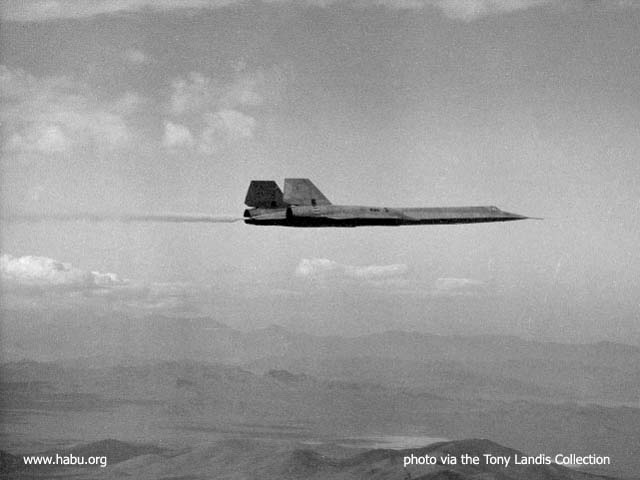
| 924 takes off on her official maiden flight, flown by Lou Schalk - Lockheed photo via John Stone |
60-6924

| 924 takes off on her official maiden flight, flown by Lou Schalk - Lockheed photo via John Stone |
|
"It was determined that we would make a high-speed taxi test going down
our 8000-foot concrete runway towards the Groom Lake bed which had probably
4-5 miles of lake bed suitable for landing beyond the end of the runway,
so that seemed like a safe direction to go. The idea was that as I reached
takeoff speed was to lift it off the ground and set it back down to see how
it felt. "Well, when we went down the runway and hit takeoff speed and lifted off, it was immediately out of control. It was oscillating longitudinally and laterally. It was obvious the airplane was very unstable. We did not have the damper systems on; no one ever turned the damper systems on on the first flight because you didn't trust them! "Finally I got hold of it, set it back down on the ground, and was probably a mile or so out on the lakebed at that point in time. Immediately disappeared into a cloud of dust. The tower called to see if I was all right. I replied 'I'm fine, I'm rolling out to slow down and turn around and taxi back.' The tower couldn't hear me becaue the antenna for my UHF transmitter was on the bottom of the fuselage and was blanked out for the direction of the tower's line of sight. So no one knew what was happening and in the dust kept waiting for the burst of flames as I ran into the mountains. After I turned the corner, if Kelly Johnson hadn't already had a heart attack, he probably breathed a sigh of relief. I taxied back in, and we talked about it that night...I said, 'Why don't we turn the dampers on before we try this again?' We all agreed that was a very good idea! |
 Another fuel dump from the same flight - photo courtesy of Tony Landis |
|
"I still didn't know what had gone wrong, but I did know we had 12 to
15 thousand pounds of fuel on board for the taxi test. Flying an F-104,
that's an awful lot of fuel, that's more that it carries, but we carried
76,000 pounds of fuel so we hardly had anything at all. It was all in
the back end. The airplane was statically unstable, which meant that anytime
you move the controls or if the airplane had any movement, you had to make
a correctional movement with the controls to stop it, otherwise it would
keep right on going; where if the airplane is stable, that means it will
tend to return to its normal position, say if it hits some rough air or
something like that. This is because of the center of gravity and
its location to the center of pressure, which is usually about the
midpoint of the wing. "We had so much fuel in the back end of the airplane that the center of gravity was about 3 percent beyond the aft limit, and we were terrifically unstable. On the actual flight where we got airborne and stayed there, we were probably 3 percent forward of where our normal fuel loading would be. The reason that happened was that the ground crew and most of the people who were getting the airplane ready for this taxi test didn't know that we had decided to lift off the airplane and set it back down again that night except for Kelly, myself and the flight test engineer...no one told them!" |

|
60-6924 completing her "official" maiden flight, April 30, 1962, flown by Lou Schalk - Lockheed photo via John Stone
While the date of this "first flight" has often been quoted as April 26, Keith Beswick was in attendance and remembers the date because it was his brother's birthday. Also, Kelly Johnson calls out the 25th in his History of the Oxcart Program: "We worked around the clock to get the bird ready for flight, and on 25 April 1962, Lou Schalk first got the aircraft into the air. He flew it about a mile and a half at altitudes of about 20 feet....On 26 April 1962, we made the official first flight." |
 continued...
continued...
06924 06925 06926 06927 06928 06929 06930 06931 06932 06933 06934 06935 06936 06937 06938 06939 06940 06941
Copyright © 1998-2021 Habu.Org